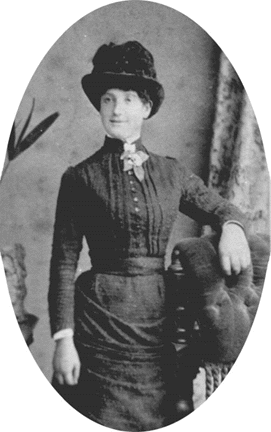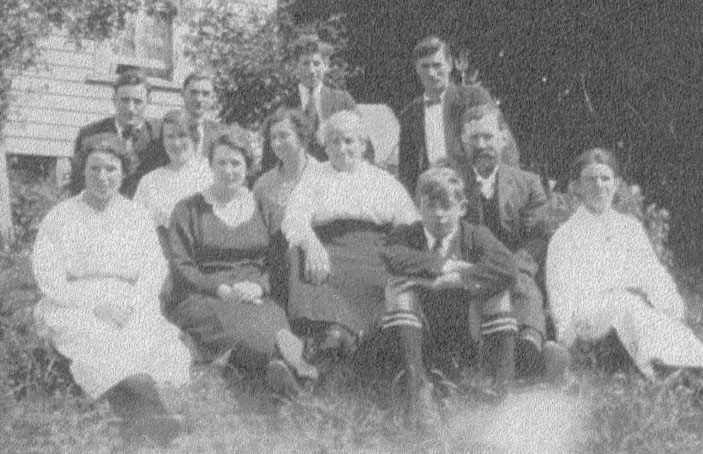Shortly after the 1881 census was taken, William's mother Jane Burrow passed away. William was just 13 years old and a student when his mother died. I have no way of knowing what William did over the next five years. By 1886 he was a farmer. Where he worked and for whom, I have no idea.
William Burrow and his wife Mary were my great grandparents. I can remember growing up and hearing the story of how Mary had two surnames. It all started with my grandmother Lily. Lily got married in 1920. On her marriage certificate she stated that her mothers name was Mary Burrow, nee Stone. But Lily's birth certificate says that her mothers name was Mary Burrow, nee Evans. I wanted to find out why Mary had two names and this is how I became interested in genealogy.
Mary Burrow nee Evans
In the 1861 census, James and Mary Evans were living in Budleigh Salterton with their twin daughters Laura and Augusta. Since noone in the family was aware that Mary Burrow (nee Evans) had any siblings, the discovery of twins came as quite a surprise.
There have been several pairs of twins in my family over the last 200 years. Mary had twin sisters and William also was descended from a twin. His father Isaac Burrow had a twin brother. My grandmother Lily had a pair of twins, although one twin died at birth. And I also have twin nieces - my sisters children.
1861 census
RG9/1381 Folio 8 Page 10 Schedule 54
Address - 50, Fore Street, Budleigh Salterton
James H. EVANS Head Married 43 Sawyer b. Budleigh Salterton 1817
Mary EVANS Wife Married 35 b. Goosemore 1826
Agusta S. EVANS Dau 1 yr 9 mo b. Budleigh Salterton 1858
Laura F. EVANS Dau 1 yr 9 mo b. Budleigh Salterton 1858
Mary Evans (the younger) was born in January 1865, and her mother Mary Evans nee Stone appears to have died in childbirth. One reason for stating this is because Charlotte Langmead (a nurse from Otterton) was the informant on young Mary's birth certificate. A second reason is a death notice for Mary Evans in the first quarter of 1865.
Deaths Mar 1865
EVANS Mary St Thomas 5b 34
In the 1871 census all three girls have been parcelled out to relatives, and there is no sign of James. It appears that he died sometime after his wife. I am still looking for confirmation. Which means Mary Evans was an orphan before she was 6 years old.
By 1871 Laura was living with Elizabeth BOLT, nee Stone and her two youngest children in Bicton. I have not yet determined exactly how Elizabeth is related to Mary Stone's family. Augusta was living with Mary Stone's sister Ann LITTLEY and her husband Edgar, in Ottery St Mary. Edgar was a baker. The twins were 11 years old. And young Mary Evans aged 6 was living with Mary Stone's brother James STONE and his wife Susan (nee Burrow daughter of William and Kezia Burrow) in Newton Poppleford.
In the 1881 census Mary (aged 16) was still living with Aunt Susan. Uncle James seems to have died some time previously. Susan had taken over the duties of running the farm and stated that she was a farmer on the 1881 census. I guess when you live with a relative for more than 10 years, its easier to use the relatives surname rather than your own. It stops all the embarrassing questions. Anyway, this explains why Mary had two surnames - one from her parents, and the other from her aunt & uncle.
According to the 1881 census, Susan's parents William and Kezia Burrow were living at Tucking Mills in Ottery St Mary, right next door to Isaac and Jane Burrow and their family. So it would be a simple matter for Mary to visit her aunt's parents and meet the boy next door. His name was also William Burrow (son of Isaac). If William Burrow senior and Isaac Burrow were related, I have not yet found the connection.
Anyway by late 1886 Mary found herself unmarried and pregnant. She and William decided it would be less embarrassing if they left home. They were married by license in Honiton in November 1886, and sailed on board the COPTIC from Plymouth in December 1886. The Coptic was a fast ship, and sailed via Tenerife, the Cape of Good Hope, and Hobart, arriving in Port Chalmers, (province of) Otago, New Zealand in January 1887 - just 4 weeks after leaving Plymouth.
I have very few photos of any of my ancestors from Devon, except for this one below. The below image is supposed to be a photo of Mary Evans in 1886, right before she and William Burrow left England and sailed for New Zealand.

Much of the information in this section and the Settlers section comes from my Aunt Laura - one of Lily's daughters - who published her life story in June 2001.
William and Mary settled down in Maclaggan Street in Dunedin where Mary gave birth to their first child Bessie Jane in April 1887. Mary stayed in Dunedin while William got a job working up in Central Otago in the Hawea Flats district. William was obviously able to make several visits back to Dunedin to see his wife, as their first son William was born in 1888 and their second son James was born in 1890.
Also in 1890 William won a ballot for a bush section in Houipapa down in the Catlins district (South Otago). The local area was called "Ribbonwood Tree Flat." William worked on railroad construction while clearing his section and building a home. Here William and Mary settled down and raised their family - which eventually grew from three to eleven children.
The next two daughters Mabel (bn 1892) and Edith (bn 1895) were born profoundly deaf. They learned to communicate with each other very well, but used sign language with the rest of the family. The fourth daughter, and sixth child, Lily, was born in Houipapa in 1897. The seventh child was another daughter Jessie, born 1899, and then came the last four boys - George born 1901, Earnest born 1904, John born 1906 and finally Frederick born 1908.
The railroad between Balclutha and Owaka had previously taken 17 years to build. Then in 1899 work began again, extending the railroad from Owaka to Houipapa. This was completed in 1905. Houipapa was the railhead for the next ten years until the rail construction between Houipapa and Tahakopa was completed in 1915. After the line to Houipapa was finished, William began working at Gwynns Sawmill, eventually rising to become a yardmaster there. Since there was no staff at the small Houipapa train station, and the Burrow house was the closest one to the station, William was seen by the local residents as the "man in charge."
Bill Burrow went beyond what would be his line of duty, and was always extremely helpful to passengers, settlers and mill workers. as noted in the booklet, "The End of the Line" published by Catlins Historical Society.
Bill Burrow loved reading and good music. He built his own radio, and even owned the latest invention, an Edison Cylinder phonograph, which gave the family much pleasure during the long winter evenings. On a Sunday, while the railway was still being built, Bill would place the phonograph beside the open window and, with the sound on high, would play records to the 40-50 people who would sit on the railway bridge listening to popular and classical music.
The Settlers LifeLiving condition were harsh - coastal drizzle and heavy clay soil compounded the famous "Catlins clay", a very fertile soil on most farms but the depair of the wagoners. Roads were just tracks, often becoming impassable in prolonged wet weather. when water was short, buckets of water was carried up the hill from the river for washing in an outside copper. The youngsters would spend their spare time fishing from the bridge, mostly catching eels which were later cooked and served for meals. There was usually a pig to keep the family supplied with bacon, some hens and two or three cows.Chores included milking the cows, gathering eggs, carrying the milk to the dairy for separating and churning into butter.
Although money was scarce, there was always plenty of food. Mary would take home-churned butter and eggs to the local store to trade for other goods. Bill had a large garden with lots of vegetables and fruit trees. He used the contents of the outhouse toilet for manure - which helped to produce some very large onions. The outhouse was an attractive little building, and it was also regularly re-papered with pictures from the New Zealand Weekly News, making it an interesting place to sit-a-while.
The Kitchen was a homely place with a shiny black coal range and a large dining table. Porridge and thick cream for breakfast was delicious. Roasted stuffed rabbits were often served with roast vegetables. Fruit pie and cream was a favourite dessert. No electricity meant that candles and lamps were the means of watching where you were going at night times. The front room did have a power kerosene light hanging from the ceiling. The kerosene was piped from a tank at the back of the house, up into the ceiling and along to the light.

The older couple in the center of the picture above, are Mary and William Burrow. I figure this photo would have been taken at or after the end of World War 1. The youngest son Frederick (in front of Mary & William) was born in 1908. Assuming he was between 10 and 12 years old in this picture, then it would have been taken between 1918 and 1920.
The Passing of Time
Mary Burrow died in Owaka in 1934. She was 69 years old. William stayed in the Houipapa district and he died in Owaka in 1955 at the age of 88. His obituary was published in the Otago Daily Times of September16, 1955.Obituary ODT 16 Sept 1955
Mr. William Burrow of Houipapa who died early this week was highly respected and possibly the last of the earliest settlers of the Catlins district.
Mr. and Mrs. Burrow arrived in New Zealand from Devonshire in 1886 and following a period of working in the Hawea District, took up in 1890 a bush section at Houipapa. Here he worked on railroad construction whilst also clearing his section and later he was engaged in sawmilling ventures.
Roading and living conditions in this district were extremely primitive and hardships unknown under present day standards were accepted as part of the pioneers life there. He was well read, fond of good music and in recent years, made radio his greatest hobby, having completely constructed several receiving sets.
The phrase of the old song writer "A fine old English gentleman," has been freely used to describe this remarkable man who at the age of 88 retained all his faculties. His wife predeceased him 21 years ago, but he leaves a family of 10, besides 30 grandchildren and 45 great grandchildren.